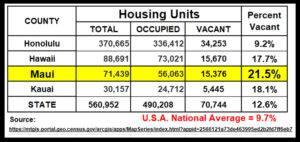
Maui County has the highest percentage of empty housing units in the state with 21.5% of all houses/condominiums/apartments classified as “vacant,” according to the 2020 U.S. Census data released last week. That’s slightly more than one in five housing units (which do not include hotel rooms or timeshares). “Vacant housing units” are defined as ones either owned by individuals who do not live in the house/condo/apartment, or ones not leased long-term by Maui County residents.
Now, Maui has dominated this category in the state for decades. Number-crunching enthusiasts can see for themselves here, courtesy of the state Department of Business, Economic Development and Tourism.
However, thanks to some creative chart and map compilations by longtime Maui economics teacher and community activist Dick Mayer, we can see in the 2020 data how those vacant housing units are clustered–and clustered they are.
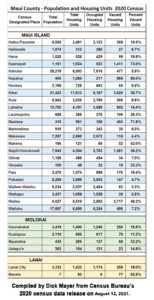
Nice House – Nobody Home
As the chart indicates, some 73% of Kaanapali’s 1,934 housing units are classified as “vacant housing units.” In Kapalua, 80%. Almost half of Wailea’s homes and condominiums are classified as “vacant,” and in Manele on Lana’i, the percentage is 92.8%, with only six of that area’s 83 housing units occupied by county residents, according to census data. By comparison, the towns of Kahului and Wailuku have far lower vacant housing unit rates: 5.9% and 7.2%, respectively. Makawao (4.4%) and Pukalani (4.7%) are similarly low.
Was Mayer surprised by the results? “No, no not at all,” he says. “We really expect most of the second homes to be where the tourists are, and where owners can expect to earn a sizable income renting to short-term tourists.”
The U.S. Census Bureau issued a map that shows the West and South sides of Maui dramatically permeated by large concentrations of vacant housing units. It’s a ghetto-ization of sorts, and before anyone starts screaming about my use of that word, I’m relying on the Oxford Dictionary definition: “Put in or restrict to an isolated or segregated place, group, or situation.” In Maui’s case, wealthy off-islanders have created their own “velvet ghettos” in some of the island’s most desirable real estate locations.
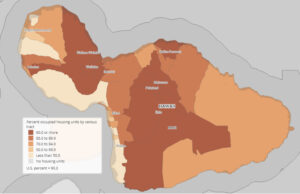
It’s no different from similar and even worse vacant housing situations in high-end resort towns like Aspen (39% vacant housing units in 2020) and Santa Fe, which both have seen second-home ownership skyrocket. That’s been detrimental to local residents, many of whom have been forced out of those cities and now face long commutes to work. On Maui, the populations of Wailuku and Kahului have shown the greatest amount of growth during the past decade, which is also where most of the “affordable” housing starts at around $600,000 (and I’m being generous).
Once those homes are priced out-of-range, there is no “moving down valley,” as many Aspen workers did. What is Maui’s working class supposed to when housing becomes financially unobtainable? Live on gigantic, off-shore barge-ominiums? Or give up and move to the mainland, which is an option many have already taken.
To illustrate the dynamics of the vacant housing unit situation, Mayer took a deeper dive into Kihei’s census tract data (see below) to examine the differences on a neighborhood-by-neighborhood basis. Kihei contains 11,813 total housing units: 3,626 or 30.7% of them are considered “vacant.” North Kihei, especially mauka of Piilani Highway, is primarily a residential community made up in many, many cases by people who work at hotels or elsewhere in the vacation industry. That’s reflected in the low vacancy rates in census tracts 303.05 (9.8%) and 303.06 (11.9%). However, the census tracts closest to Wailea, such as 307.09, show a vacant housing unit rate of 53.2%. And look at Wailea/Makena’s census tract 303.07, with 68.1% vacant units!
Says Mayer, “The further south you go, those neighborhoods are now places where non-resident owners keep homes.”
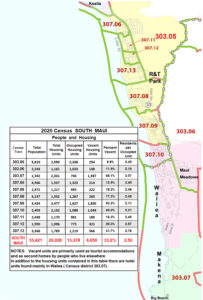
“These second homes are major contributors to our visitor glut, as they are non-commercial visitor accommodations not only for their off-island owners, but for those owners’ families and friends,” said Maui Tomorrow Foundation Chair Michael Williams. “All these visitors use our roads, beaches, parks, trails, water, and wastewater treatment plants, but pay little in taxes to support that county infrastructure. Second homeowners do not pay income taxes nor Transient Accommodation Taxes, while Maui’s property tax rates on them are some of the lowest in the country. Those wealthy people should be paying much more in property taxes to carry a fair share of the financial burden of keeping Maui no ka oi.”
Sadly, empty expensive dwellings seem to attract even more buyers of empty, expensive dwellings, expanding these South and West Maui velvet ghettos, and making it increasingly unlikely that local residents will ever have a shot at living their dreams–at least not in those neighborhoods.

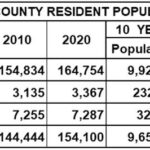

The vacant housing in Lahaina, Launiupoko, Kaanapali, Mahinahina , Napili and Kapalua are mainly the illegal vacation rentals with absentee owners.
They are rented but not recorded.
When car rentals became expensive we saw all the tourists walking out of the residential and agriculturally zone areas.
Dick Mayer, so glad you’re still on it!! Excellent report. My son is a tradesmen who has refused to go to Wailea for years now because the homes and yards are perfectly maintained, and no one’s in them.